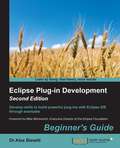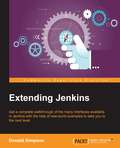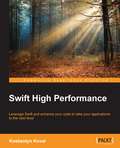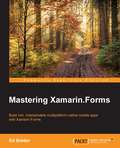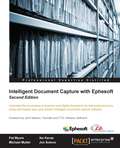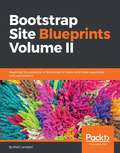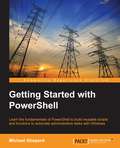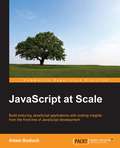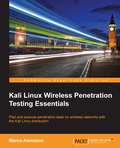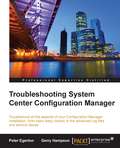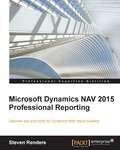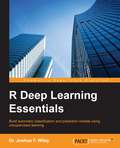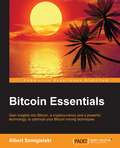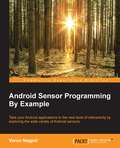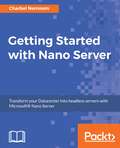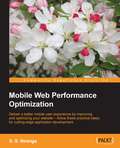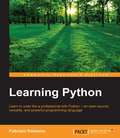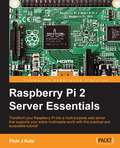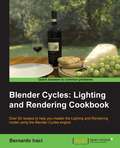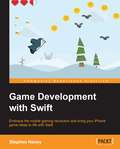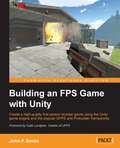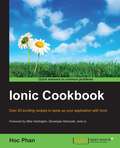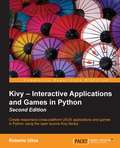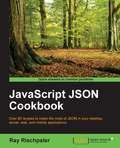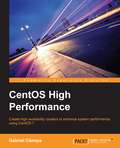- Table View
- List View
Eclipse Plug-in Development: Beginner's Guide - Second Edition
by Dr Alex BlewittDevelop skills to build powerful plug-ins with Eclipse IDE through examples About This Book * Create useful plug-ins to make Eclipse work for you * Learn how to migrate Eclipse 3.x plug-ins to Eclipse 4.x * From automation to testing, find out how to get your IDE performing at an impressive standard Who This Book Is For This book is for Java developers familiar with Eclipse who need more from the IDE. This book will sharpen your confidence and make you a more productive developer with a tool that supports rather than limits you. What You Will Learn * Create plug-ins for Eclipse 4.x * Test plug-ins automatically with JUnit * Display tree and table information in views * Upgrade Eclipse 3.x plug-ins to Eclipse 4.x * Find out how to build user interfaces from SWT and JFace * Run tasks in the background and update the user interface asynchronously * Automate builds of plug-ins and features * Automate user interface tests with SWTBot In Detail Eclipse is used by everyone from indie devs to NASA engineers. Its popularity is underpinned by its impressive plug-in ecosystem, which allows it to be extended to meet the needs of whoever is using it. This book shows you how to take full advantage of the Eclipse IDE by building your own useful plug-ins from start to finish. Taking you through the complete process of plug-in development, from packaging to automated testing and deployment, this book is a direct route to quicker, cleaner Java development. It may be for beginners, but we're confident that you'll develop new skills quickly. Pretty soon you'll feel like an expert, in complete control of your IDE. Don't let Eclipse define you - extend it with the plug-ins you need today for smarter, happier, and more effective development. Style and approach Packed with plenty of examples so you're never stuck, or never left simply reading instructions, this book encourages you to get started immediately. This book is for developers who want to develop, not just learn.
Extending Jenkins
by Donald SimpsonGet a complete walkthrough of the many interfaces available in Jenkins with the help of real-world examples to take you to the next level with Jenkins About This Book * Find out how to interact with Jenkins from within Eclipse, NetBeans, and IntelliJ IDEA * Develop custom solutions that act upon Jenkins information in real time * A step-by-step, practical guide to help you learn about extension points in existing plugins and how to build your own plugin Who This Book Is For This book is aimed primarily at developers and administrators who are interested in taking their interaction and usage of Jenkins to the next level. The book assumes you have a working knowledge of Jenkins and programming in general, and an interest in learning about the different approaches to customizing and extending Jenkins so it fits your requirements and your environment perfectly. What You Will Learn * Retrieve and act upon Jenkins information in real time * Find out how to interact with Jenkins through a variety of IDEs * Develop your own Form and Input validation and customization * Explore how Extension points work, and develop your own Jenkins plugin * See how to use the Jenkins API and command-line interface * Get to know how to remotely update your Jenkins configuration * Design and develop your own Information Radiator * Discover how Jenkins customization can help improve quality and reduce costs In Detail Jenkins CI is the leading open source continuous integration server. It is written in Java and has a wealth of plugins to support the building and testing of virtually any project. Jenkins supports multiple Software Configuration Management tools such as Git, Subversion, and Mercurial. This book explores and explains the many extension points and customizations that Jenkins offers its users, and teaches you how to develop your own Jenkins extensions and plugins. First, you will learn how to adapt Jenkins and leverage its abilities to empower DevOps, Continuous Integration, Continuous Deployment, and Agile projects. Next, you will find out how to reduce the cost of modern software development, increase the quality of deliveries, and thereby reduce the time to market. We will also teach you how to create your own custom plugins using Extension points. Finally, we will show you how to combine everything you learned over the course of the book into one real-world scenario. Style and approach Extending Jenkins explores and explains advanced Jenkins functionality from a practical point of view, teaching you real-world skills that will help you get more from this powerful software. Each key topic is explained clearly with a practical example, and in sufficient detail so you understand the concepts and can then develop your own solutions using your preferred software and languages.
Swift High Performance
by Kostiantyn KovalLeverage Swift and enhance your code to take your applications to the next levelAbout This BookBuild solid, high performance applications in SwiftIncrease your efficiency by getting to grips with concurrency and parallel programmingUse Swift to design performance-oriented solutionsWho This Book Is ForThis book is aimed at experienced Swift developers wanting to optimize their programs on Apple platforms to optimize application performance.What You Will LearnBuild solid, stable, and reliable applications using SwiftUse REPL and Pl to manage and configure relational databasesExplore Swift's features including its static type system, value objects, and functional programming Design reusable code for high performance in SwiftUse to Xcode LLBD and REPL to debug commandsAvoid sharing resources by using concurrency and parallel programmingUnderstand the lazy loading pattern, lazy sequences, and lazy evolution.In DetailSwift is one of the most popular and powerful programming languages for building iOS and Mac OS applications, and continues to evolve with new features and capabilities. Swift is considered a replacement to Objective-C and has performance advantages over Objective-C and Python. Swift adopts safe programming patterns and adds modern features to make programming easier, more flexible, and more fun.Develop Swift and discover best practices that allow you to build solid applications and optimize their performance.First, a few of performance characteristics of Swift will be explained. You will implement new tools available in Swift, including Playgrounds and REPL. These will improve your code efficiency, enable you to analyse Swift code, and enhance performance. Next, the importance of building solid applications using multithreading concurrency and multi-core device architecture is covered, before moving on to best practices and techniques that you should utilize when building high performance applications, such as concurrency and lazy-loading. Finally, you will explore the underlying structure of Swift further, and learn how to disassemble and compile Swift code.Style and approachThis is a comprehensive guide to enhancing Swift programming techniques and methodology to enable faster application development.
Mastering Xamarin.Forms
by Ed SniderBuild rich, maintainable multiplatform native mobile apps with Xamarin.Forms About This Book * Build an effective mobile app architecture with the Xamarin.Forms toolkit * Maximize the testability, flexibility, and overall quality of your Xamarin.Forms mobile app * This step-by-step tutorial is packed with real-world scenarios and solutions to build professional grade mobile apps with Xamarin.Forms Who This Book Is For This book is intended for C# developers who are familiar with the Xamarin platform and the Xamarin.Forms toolkit. If you have already started working with Xamarin.Forms and want to take your app to the next level and make it more maintainable, testable, and flexible, then this book is for you. What You Will Learn * Find out how, when, and why you should use architecture patterns and get best practices with Xamarin.Forms * Implement the Model-View-ViewModel (MVVM) pattern and data-binding in Xamarin.Forms mobile apps * Extend the Xamarin.Forms navigation API with a custom ViewModel-centric navigation service * Leverage the inversion of control and dependency injection patterns in Xamarin.Forms mobile apps * Work with online and offline data in Xamarin.Forms mobile apps * Test both business logic and user interface code in Xamarin.Forms mobile apps * Use platform-specific APIs to build rich custom user interfaces in Xamarin.Forms mobile apps * Explore how to improve mobile app quality with analytics and crash reporting using Xamarin Insights In Detail Discover how to extend and build upon the components of the Xamarin.Forms toolkit to develop an effective, robust mobile app architecture. Starting with an app built with the basics of the Xamarin.Forms toolkit, we'll go step by step through several advanced topics to create a solution architecture rich with the benefits of good design patterns and best practices. We'll start by introducing a core separation between the app's user interface and the app's business logic by applying the MVVM pattern and data binding. Discover how to extend and build upon the components of the Xamarin.Forms toolkit to develop an effective, robust mobile app architecture. Starting with an app built with the basics of the Xamarin.Forms toolkit, we'll go step by step through several advanced topics to create a solution architecture rich with the benefits of good design patterns and best practices. We'll start by introducing a core separation between the app's user interface and the app's business logic by applying the MVVM pattern and data binding. Then we will focus on building out a layer of plugin-like services that handle platform-specific utilities such as navigation, geo-location, and the camera, as well as how to use these services with inversion of control and dependency injection. Next we'll connect the app to a live web-based API and set up offline synchronization. Then, we'll dive into testing the app--both the app logic through unit tests and the user interface using Xamarin's UITest framework. Finally, we'll integrate Xamarin Insights for monitoring usage and bugs to gain a proactive edge on app quality. Style and approach This easy-to-follow, code-rich guide will walk you through building a real-world Xamarin.Forms mobile app from start to finish. Each chapter builds upon the app by applying new advanced functionalities, design patterns, and best practices.
Intelligent Document Capture with Ephesoft - Second Edition
by Ike Kavas Pat MyersAutomate the processing of scanned and digital documents by improving accuracy using web-based open and modern intelligent document capture software About This Book * Learn how to implement the benefits of intelligent document capture using Ephesoft Enterprise 4 * Leverage the power of the open platform to run it as a classic intake capture system to make your current portals or applications more intelligent * A practical guide providing examples for optimizing document capture for your business Who This Book Is For This book is intended for information technology professionals interested in installing and configuring Ephesoft Enterprise for their organization, but it is a valuable resource for anyone interested in learning about intelligent document capture. What You Will Learn * Discover the benefits of using intelligent document capture in your work place * Learn to capture, classify, and separate any type of document * Extract important information from your documents * Transfer the documents and data into your content management system * Customize Ephesoft to meet your unique business requirements * Understand the integration techniques using the Ephesoft web services API * Convert your paper archive to electronic records efficiently * Automate business processes that depend on documents in paper, fax, or email attachment format * Implement distributed capture for mailroom automation In Detail Every organization, public or private, processes documents in various formats, especially paper and fax formats. Processing documents manually is an expensive and time-consuming endeavor. Ephesoft Enterprise is a modern document capture solution that allows an organization to automate the business process. It uses powerful technology to classify and capture the vital information from the document's content. This helps to minimize the time your company spends on reviewing and processing any physical and electronic documents. This book teaches you about document capture in general and implementation of document capture using Ephesoft. Start by learning about document capture and how Ephesoft revolutionized the industry. Progress to a tour of key features, including operator and administrator interfaces and then learn to configure Ephesoft to process your business's specific document types and extract content from those documents. You will also get to know the advanced customization techniques that make Ephesoft accommodate your unique business needs. Finally, the book concludes by teaching you how to embed the classification and extraction functionality using Ephesoft's web services. By the end, you will learn to optimize the processing of your documents, saving your company time and money. Style and approach This is a step-by-step guide on how to configure and use Ephesoft using an accounts payable use case. The book will start with basic techniques and progress to more advanced features that allow you to leverage the power for a modern powerful capture system.
Bootstrap Site Blueprints Volume II
by Matt LambertBootstrap Site Blueprints Volume II is geared for developers of all experience levels. It is written in a concise, easy-to-understand way. Each project follows a step-by-step process that anyone can understand. Some experience with Bootstrap beforehand would definitely be an asset but is not required.
Getting Started with PowerShell
by Michael ShepardLearn the fundamentals of PowerShell to build reusable scripts and functions to automate administrative tasks with Windows About This Book * Harness the capabilities of the PowerShell system to get started quickly with server automation * Learn to package commands into a reusable script and add control structures and parameters to make them flexible * Get to grips with cmdlets that allow you to perform administration tasks efficiently Who This Book Is For This book is intended for Windows administrators or DevOps users who need to use PowerShell to automate tasks. Whether you know nothing about PowerShell or know just enough to get by, this guide will give you what you need to go to take your scripting to the next level. What You Will Learn * Learn to verify your installed version of PowerShell, upgrade it, and start a PowerShell session using the ISE * Discover PowerShell commands and cmdlets and understand PowerShell formatting * Use the PowerShell help system to understand what particular cmdlets do * Utilise the pipeline to perform typical data manipulation * Package your code in scripts, functions, and modules * Solve common problems using basic file input/output functions * Find system information with WMI and CIM * Automate IIS functionality and manage it using the WebAdministration module In Detail Windows PowerShell is a task-based command-line shell and scripting language designed specifically for system administration. Built on the .NET Framework, Windows PowerShell helps IT professionals and power users control and automate the administration of the Windows operating system and applications that run on Windows. PowerShell is great for batch importing or deleting large sets of user accounts and will let you collect a massive amount of detailed system information in bulk via WMI (Windows Management Instrumentation). Getting Started with PowerShell is designed to help you get up and running with PowerShell, taking you from the basics of installation, to writing scripts and web server automation. This book, as an introduction to the central topics of PowerShell, covers finding and understanding PowerShell commands and packaging code for reusability, right through to a practical example of automating IIS. It also includes topics such as installation and setup, creating scripts, automating tasks, and using Powershell to access data stores, registry, and file systems. You will explore the PowerShell environment and discover how to use cmdlets, functions, and scripts to automate Windows systems. Along the way, you will learn to perform data manipulation and solve common problems using basic file input/output functions. By the end of this book, you will be familiar with PowerShell and be able to utilize the lessons learned from the book to automate your servers. Style and approach A practical learning guide, complete with plenty of activities, examples and screenshots.
JavaScript at Scale
by Adam BoduchBuild web applications that last, with scaling insights from the front-line of JavaScript development About This Book Design and implement JavaScript application architectures that scale from a number of perspectives, such as addressability, configurability, and performance Understand common JavaScript scaling pitfalls and how to tackle them through practical, real-world, solutions and strategies Learn techniques to deliver reusable architectures that stand the test of time Who This Book Is For Have you ever come up against an application that felt like it was built on sand? Maybe you've been tasked with creating an application that needs to last longer than a year before a complete re-write? If so, JavaScript at Scale is your missing documentation for maintaining scalable architectures. There's no prerequisite framework knowledge required for this book, however, most concepts presented throughout are adaptations of components found in frameworks such as Backbone, AngularJS, or Ember. All code examples are presented using ECMAScript 6 syntax, to make sure your applications are ready for next generation browsers. What You Will Learn Identify and evaluate the external scaling influencers of your application Build out component composition in large-scale JavaScript applications Design for inter-component communication that scale Understand the importance of addressable resources in JavaScript applications, and approaches to scaling addressability Customize and configure components to meet scaling demands Ensure a highly-performant user experience, despite the size and complexity of your application Design a portable and testable application that's not constrained to one environment Make architectural trade-offs by removing or refactoring components Design components that fail in a scalable way In Detail JavaScript applications of today look a lot different from their predecessors of just five years ago. Because of this rapid growth in sophistication and capabilities, we've seen an explosion in JavaScript frameworks; the JavaScript development landscape is a fragmented one. To build large-scale JavaScript applications, we need more than just tools – we need scalable architectures. We create scalable JavaScript architectures by looking at what aspects of our application need to scale and why. Only then can we apply the best patterns and components to our architecture, scaling it into the future. JavaScript at Scale will show you how to deal with scalability from a number of perspectives; addressability, testability and component composition. The book begins by defining ‘scale’ from a JavaScript point of view, and dives into the influencers of scale, as well as scalable component composition and communication. We will also look at how large-scale architectures need the ability to scale down, and recover from failing components, as well as scale up and manage new features or a large user base. Filled with real-world JavaScript scaling scenarios, and code-first examples, JavaScript at Scale is your guide to building out applications that last. Each topic is covered in a way that it can be applied to your own unique scenarios; by understanding the fundamentals of a scaling issue, you’ll be able to use that knowledge to tackle even the most difficult of situations. The code examples follow the same approach, using ECMAScript 6 syntax that can be translated to the framework of choice.
Kali Linux Wireless Penetration Testing Essentials
by Marco AlamanniThis book is targeted at information security professionals, penetration testers and network/system administrators who want to get started with wireless penetration testing. No prior experience with Kali Linux and wireless penetration testing is required, but familiarity with Linux and basic networking concepts is recommended.
Troubleshooting System Center Configuration Manager
by Gerry Hampson Peter EgertonTroubleshoot all the aspects of your Configuration Manager installation, from basic easy checks to the advanced log files and serious issues About This Book * Learn to troubleshoot Configuration Manager 2012 based versions of Microsoft System Center * Understand the usability of tools and find resolutions to all the issues of Configuration Manager * A step-by-step practical guide with the necessary screenshots and examples Who This Book Is For If you are new to Configuration Manager or have experience with it, and are interested in identifying, diagnosing and resolving the System Center Configuration Manager administration issues then this book is for you. What You Will Learn * Fix your clients and install them correctly * Understand how your Configuration Manager hierarchy works * Extend your error information * Troubleshoot Configuration Manager roles * Know your options when faced with problems * Prevent future problems occurring In Detail Microsoft System Center Configuration Manager is the most popular enterprise client management solution in the world with some of the best features available. Troubleshooting this product, however, is not always as simple as you might want, not least getting to know the hundreds of log files and understanding how the various components work. The book starts with discussing the most commonly used tools for troubleshooting the variety of problems that can be seen in Configuration Manager. It then moves to providing a high level view of the available log files, their locations, what they relate to and what they typically contain. Next, we will look at how we can fully utilize and extend all the available information from the console monitoring pane through to the status messages and down into error logging with some further reaches into WMI, SQL, registry and the file structure. You will then learn what the common error codes mean, how to make sense of the less common ones and what they actually mean with respect to Configuration Manager. Further to this, you will pick up widely acknowledged best practices both from a proactive stance when carrying out your daily administrative tasks and also from a reactive position when the green lights start to turn red right down to a complete failure situation. By the end of the book, you will be competent enough to identify and diagnose the root causes of System Center Configuration Manager administration issues and resolving them. Style and approach An easy to follow yet practical guide that will advise you on what tools and information you have available to troubleshoot with, if you can extend that information and what to look for solving the issues.
Microsoft Dynamics NAV 2015 Professional Reporting
by Steven Renders<P><P>Discover tips and trick for Dynamics NAV report building <P><P>About This Book <P><P>Create and customize reports in Dynamics NAV 2015 using RDLC, Word, Power BI, and Reporting Services <P><P>Work with different elements in the toolbox such as tablix, which can be used as a List, Table, or Matrix and understand the differences between them and when to use which <P><P>This book is a pragmatic guide with clear instructions and real-world examples to teach you about the reporting capabilities of Dynamics NAV 2015 <P><P>Who This Book Is For <P><P>If you are a consultant, developer, customer, user, or just interested in the reporting capabilities of Dynamics NAV, then this book is for you. <P><P>Basic knowledge of Dynamics NAV will be helpful. <P><P>What You Will Learn <P><P>Understand why reports are designed in a specific way and then apply this knowledge to your advantage <P><P>Develop document reports using different techniques <P><P>Apply filtering and sorting, and create groups <P><P>Use RDLC to visualize information <P><P>Visualize information, KPIs, and trends using expressions, Gauges, Charts, Data bars, Indicators, and Spark lines <P><P>Create and optimize your dataset for RDLC and for Word layouts <P><P>Use Power BI with Dynamics NAV to bring your data to life <P><P>Build Reporting Services reports on top of Dynamics NAV <P><P>In Detail <P><P>Microsoft Dynamics NAV is a multi-lingual, multi-currency business management solution that organizations use to manage their accounts, supply chain, sales, payroll, and HR. It is an ERP tool for organizations that is fast to implement, easy to configure, and simple to use. It is widely used because simplicity is a part of its development, product design, usability, and implementation. <P><P>This book will help you to master, analyze, and deliver the most challenging reporting requirements in Dynamics NAV 2015. <P><P>The book starts by explaining report development and it's different phases such as data model, layout, and testing you go through. It introduces you to RDLC and the different controls in the toolbox, such as the Tablix, in its many forms. You will learn to use expressions to make your layout dynamic and to overcome typical problems. <P><P>Moving on, the book will teach you to visualize data and be able to understand and read a report as it is intended. You will also learn to use Microsoft Word to create a layout for a report. With Power BI and Power Pivot, Power View, and Power Map, you will learn how easy and powerful it is to bring your data to life, so you can spot trends and perform in depth analysis of your business. Reporting Services is also explained as another way that you can apply the knowledge you have about RDLC to build RDL layouts outside of Dynamics NAV. <P><P>By the end, you will create different types of charts so you can visualize key performance indicators inside the Dynamics NAV application. <P><P>Style and approach <P><P>This book is an essential guide in to understanding what is involved in creating reports in Dynamics NAV and its reporting capabilities.
R Deep Learning Essentials
by Dr Joshua WileyThis book caters to aspiring data scientists who are well versed with machine learning concepts with R and are looking to explore the deep learning paradigm using the packages available in R. You should have a fundamental understanding of the R language and be comfortable with statistical algorithms and machine learning techniques, but you do not need to be well versed with deep learning concepts.
Bitcoin Essentials
by Albert Szmigielski<p>Blockchain is being billed as the technology of the future. Bitcoin is the first application of that technology. Mining is what makes it all possible. Exploring mining from a practical perspective will help you make informed decisions about your mining setup. Understanding what the future may hold for blockchains, and therefore for mining, will help you position yourself to take advantage of the impending changes. <p>This practical guide starts with an introduction to Bitcoin wallets, as well as mining hardware and software. You will move on to learn about different mining techniques using the CPU, GPU, FPGA, and ultimately the ASIC as an example. After this, you will gain an insight into solo mining and pool mining, and see the differences between the two. The book will then walk you through large-scale mining and the challenges faced during such operations. Finally, you will take a look into the future to see a world where blockchain-based applications are commonplace and mining is ubiquitous.</p>
Android Sensor Programming By Example
by Varun NagpalTake your Android applications to the next level of interactivity by exploring the wide variety of Android sensors About This Book * Get a thorough understanding of the fundamentals and framework of Android sensors. * Acquire knowledge of advance sensor programming, and learn how to connect and use sensors in external devices such as the Android Watch, Polar heart rate monitors, Adidas speed cells, and so on. * Learn from real-world sensor-based applications such as the Pedometer app to detect daily steps, the Driving app to detect driving events, and the Professional Fitness tracker app to track heart rate, weight, daily steps, calories burned, and so on. Who This Book Is For This book is targeted at Android developers who want to get a good understanding of sensors and write sensor-based applications, or who want to enhance their existing applications with additional sensor functionality. A basic knowledge of Android development is required What You Will Learn * Learn about sensor fundamentals, different types of sensors, and the sensor co-ordinate system * Understand the various classes, callbacks, and APIs of the Android Sensor framework * Check all the available sensors on an Android device and know their individual capabilities--for example, their range of values, power consumption, and so on. * Implement sensor fusion using two or more sensors together and learn to compensate for the weakness of one sensor by using the strength of another * Build a variety of sensor based, real-world applications such as Weather, Pedometer, Compass, Driving Events Detection, Fitness Tracker, and so on. * Get to know about wake up and non-wake up sensors, wake locks, and how to use sensor batch processing along with the sensor hardware FIFO queue * Develop efficient battery and processor algorithms using raw sensor data to solve real-world problems * Connect to a variety of remote sensors such as body weight measurement and body fat percentage measurement using the Google Fit platform from your Android app In Detail Android phones available in today's market have a wide variety of powerful and highly precise sensors. Interesting applications can be built with them such as a local weather app using weather sensors, analyzing risky driving behavior using motion sensors, a fitness tracker using step-counter sensors, and so on. Sensors in external devices such as Android Watch, Body Analyzer & Weight Machine, Running Speed Cell, and so on can also be connected and used from your Android app running on your phone. Moving further, this book will provide the skills required to use sensors in your Android applications. It will walk you through all the fundamentals of sensors and will provide a thorough understanding of the Android Sensor Framework. You will also get to learn how to write code for the supportive infrastructure such as background services, scheduled and long running background threads, and databases for saving sensor data. Additionally, you will learn how to connect and use sensors in external devices from your Android app using the Google Fit platform. By the end of the book, you will be well versed in the use of Android sensors and programming to build interactive applications. Style and approach A step-by-step and easy-to-follow guide that focuses on utilizing sensors to perform certain tasks. After covering the fundamentals in the first chapter, the book develops the concepts by building a real-world, sensor-based application in subsequent chapters.
Getting Started with Windows Nano Server
by Charbel NemnomThis book opens up new potential for both developers and IT pros alike. The book is primarily for Windows Server administrators and IT Professionals who would like to deploy and administer Windows Nano Server within their organizations, and for developers who are trying to make maximum use of Windows Server Containers and Hyper-V Containers with Nano Servers.
Mobile Web Performance Optimization
by S. S. NirangaDeliver a better mobile user experience by improving and optimizing your website - follow these practical steps for cutting-edge application development About This Book * Optimize your website or application for an improved mobile performance * Learn how to create lightweight, intuitive mobile UI and make sure it's supported by a robust application architecture * Find out how to improve the performance of your applications by asking the right design questions at each stage in the development workflow Who This Book Is For This book has been created for web developers who want to optimize their website for today's mobile users. If you understand just how important user experience is, this book is for you - it will help you throughout the entire optimization process. What You Will Learn * Learn the three pillars of mobile performance * Find out how to ask - and answer - crucial design questions such as 'mobile or responsive?' * Learn how to minify CSS and JavaScript for improved performance * Monitor and debug your website with the leading browser testing tools * Explore the impact of caching on performance - and improve it using JavaScript and CSS frameworks * Make third-party plugins your friend - avoid common issues and pitfalls In Detail With users increasingly accessing the web on mobile devices, it's crucial to make sure your website is built to seamlessly fit this radical change in user behavior. Mobile Web Performance Optimization is designed to help you do exactly that - it's been created to help you build fast, and mobile-user-friendly websites and applications. Featuring guidance through a range of techniques and tools essential to modern mobile development, this accessible guide will make sure you're delivering a seamless and intuitive experience for your website's users. Begin by exploring the fundamental components of mobile web design and website optimization, before learning how to put the concepts into practice. Featuring cross-platform solutions, insights on developing lightweight yet robust UI, and insights on how to successfully manage data, this application development book takes you through every stage in the development process - so you can be confident that you're asking the right questions and using the best tools in the most effective way. By the end, you'll understand implicitly what it means to 'build for performance'- you'll be a more confident developer, capable of building projects that adapt to a changing world. Style and approach This book takes a step-by-step approach to mobile web optimization, explaining the topics in a conversational and easy-to-follow style. Each topic includes detailed explanations of the basic and advanced features of mobile web optimization.
Learning Python
by Fabrizio RomanoLearn to code like a professional with Python - an open source, versatile and powerful programming language About This Book * Learn the fundamentals of programming with Python - one of the best languages ever created * Develop a strong set of programming skills that you will be able to express in any situation, on every platform, thanks to Python's portability * Create outstanding applications of all kind, from websites to scripting, and from GUIs to data science Who This Book Is For Python is the most popular introductory teaching language in U.S. top computer science universities, so if you are new to software development, or maybe you have little experience, and would like to start off on the right foot, then this language and this book are what you need. Its amazing design and portability will help you become productive regardless of the environment you choose to work with. What You Will Learn * Get Python up and running on Windows, Mac, and Linux in no time * Grasp the fundamental concepts of coding, along with the basics of data structures and control flow. * Write elegant, reusable, and efficient code in any situation * Understand when to use the functional or the object oriented programming approach * Create bulletproof, reliable software by writing tests to support your code * Explore examples of GUIs, scripting, data science and web applications * Learn to be independent, capable of fetching any resource you need, as well as dig deeper In Detail Learning Python has a dynamic and varied nature. It reads easily and lays a good foundation for those who are interested in digging deeper. It has a practical and example-oriented approach through which both the introductory and the advanced topics are explained. Starting with the fundamentals of programming and Python, it ends by exploring very different topics, like GUIs, web apps and data science. The book takes you all the way to creating a fully fledged application. The book begins by exploring the essentials of programming, data structures and teaches you how to manipulate them. It then moves on to controlling the flow of a program and writing reusable and error proof code. You will then explore different programming paradigms that will allow you to find the best approach to any situation, and also learn how to perform performance optimization as well as effective debugging. Throughout, the book steers you through the various types of applications, and it concludes with a complete mini website built upon all the concepts that you learned. Style and approach This book is an easy-to-follow guide that will take you from a novice to the proficient level at a comfortable pace, using a lot of simple but effective examples. Each topic is explained thoroughly, and pointers are left for the more inquisitive readers to dig deeper and expand their knowledge.
Raspberry Pi Server Essentials
by Piotr J. KulaThis is an engaging, easy to follow guide for developing a wide range of server projects with Raspberry Pi This book is targeted towards all Raspberry Pi enthusiasts who are interested in exploring the potential of Pi as a server. Even if you have no prior experience with the Raspberry Pi, you can pick up this book and develop a wide range of projects.
Blender 3D Incredible Machines
by Christopher KuhnDesign, model, and texture complex mechanical objects in Blender About This Book * Develop realistic and awesome machines for your 3D projects and animation films * Gain the ability to look at a piece of machinery in real life and then recreate it in Blender * Develop a comprehensive skill set covering key aspects of mechanical modeling Who This Book Is For This book is intended for consumers and hobbyists who are existing users of Blender 3D want to expand their capabilities by diving into machine modeling with Blender 3D. You are expected to have experience with basic Blender operations. What You Will Learn * Reacquaint yourself with Blender's modeling toolset * Practice fundamental skills that are applicable to a range of modeling projects * Know when and where to use various types of geometry--something that saves time in one instance will pose significant problems in another * Think ahead and plan your project out to significantly improve both quality and efficiency * Create models for freestyle use * Overcome challenging modeling problems * Create customized game models that can easily be exported to other formats. This is one of the most popular uses of Blender, and the results can be incorporated into game design! * Get comfortable with the start-to-finish process to create any type of hard surface model In Detail Blender 3D is one of the top pieces of 3D animation software. Machine modeling is an essential aspect of war games, space games, racing games, and animated action films. As the Blender software grows more powerful and popular, there is a demand to take your modeling skills to the next level. This book will cover all the topics you need to create professional models and renders. This book will help you develop a comprehensive skill set that covers the key aspects of mechanical modeling. Through this book, you will create many types of projects, including a pistol, spacecraft, robot, and a racer. We start by making a Sci-fi pistol, creating its basic shape and adding details to it. Moving on, you'll discover modeling techniques for larger objects such as a space craft and take a look at how different techniques are required for freestyle modeling. After this, we'll create the basic shapes for the robot and combine the meshes to create unified objects. We'll assign materials and explore the various options for freestyle rendering. We'll discuss techniques to build low-poly models, create a low-poly racer, and explain how they differ from the high poly models we created previously. By the end of this book, you will have mastered a workflow that you will be able to apply to your own creations. Style and approach This is an easy-to-follow book that is based around four concrete projects. Each topic is explained sequentially in the process of creating a model, and detailed explanations of the basic and advanced features are also included.
Game Development with Swift
by Stephen HaneyIf you wish to create and publish fun iOS games using Swift, then this book is for you. You should be familiar with basic programming concepts. However, no prior game development or Apple ecosystem experience is required.
Building an FPS Game with Unity
by John P. DoranCreate a high-quality first person shooter game using the Unity game engine and the popular UFPS and Probuilder frameworksAbout This BookLearn how to use Unity in conjunction with UFPS and ProBuilder to create a high-quality game quicklyCreate both interior and exterior environmentsA step-by step guide to building a project with clear examples and instructions to create a number of interesting scenariosWho This Book Is ForThis book is for those who want to create an FPS game in Unity and gain knowledge on how to customize it to be their very own. If you are familiar with the basics of Unity, you will have an easier time, but it should make it possible for someone with no prior experience to learn Unity at an accelerated pace.What You Will LearnUse UFPS to build custom weapons with custom meshes and behaviorsExplore level design as you prototype levels, making use of Prototype to build levels out quicklyBuild environments that are realistic as possible while keeping peak performance and repetitiveness downReview tips and tricks on how to create environments using both terrain for outdoor areas and a modular workflow for interiorsDevelop a number of different encounters that your players can fight against, from a simple turret enemy to complex AI characters from Shooter AIDiscover how to create unique objects such as exploding barrels and objects you can interact withCreate a custom GUI to help your game stand out from the crowdPackage your game for release, create an installer, and get your game out into the worldIn DetailUnity, available in free and pro versions, is one of the most popular third-party game engines available. It is a cross-platform game engine, making it easy to write your game once and then port it to PC, consoles, and even the web, making it a great choice for both indie and AAA developers.Building an FPS Game in Unity takes readers on an exploration of how to use Unity to create a 3D first person shooter (FPS) title, leveraging the powerful UFPS framework by VisionPunk and Prototype/ProBuilder 2.0 by ProCore3D.After some setting up, you will start by learning how to create custom weapons, prototype levels, create exterior and interior environments, and breathe life into our levels. We will then add polish to the levels. Finally, we will create a custom GUI and menus for our title to create a complete package.Style and approachAn easy-to-follow guide with each project containing step-by-step explanations, diagrams, screenshots, and downloadable material. Concepts in Unity and C# are explained as they are used and for the more inquisitive, there are more details on the concepts used with additional external resources to learn from.
Ionic Cookbook
by Hoc PhanOver 35 exciting recipes to spice up your application development with IonicAbout This BookLearn how to utilize the robust features of Ionic CLI and its framework to create, develop, and build your mobile appExplore new integrations with various Backend-as-a-Services, along with AngularJS modules, for creative solutionsUse out-of-the-box Ionic functionalities, customize existing components, and add new components with this comprehensive, step-by-step guideWho This Book Is ForIf you are a front-end developer and want to take advantage of your existing mobile application development skills to develop cross-platform mobile apps, this book is for you. You will build up your Ionic knowledge with in-depth recipes on Angular.js, Cordova, and Sass.What You Will LearnAuthenticate users using an e-mail password, Twitter, Facebook, Google+, and LinkedInRetrieve data and store it using FirebaseAccess native device functionalities such as a camera, contact list, e-mail, and maps using ngCordovaWork with localStorage and SQLite for persistent data access on the client sideCommunicate to and from your app using push notifications or SMSLeverage AngularJS events and Ionic-specific events to communicate across pages, controllers, and directivesCustomize the color and theme of your Ionic appCreate new custom directives as componentsCompile your app for iOS, Android, and Windows PhoneIn DetailThe world of mobile development is extremely fragmented with many platforms, frameworks, and technologies available. Ionic is intended to fill that gap, by enabling developers to build apps that have a native feel to them, using web technologies such as HTML, CSS, and AngularJS. Ionic makes it easy for front-end developers to become app developers. The framework provides superior performance with deep Cordova integration and a comprehensive set of tools for prototyping, backend support, and deployment.Ionic Cookbook takes you through the process of developing a cross-platform mobile app using just HTML5 and the JavaScript-based Ionic.You will start with an introduction to the CLI and then move on to building and running an app. You will explore common features of real-world mobile apps such as authenticating a user, and getting and saving data using either Firebase or Local Storage. Next, the book covers how Ionic integrates with Cordova to support native device features using ngCordova, and you will discover how to take advantage of existing modules around its ecosystem. You will also delve into advanced topics, including how to extend Ionic to create new components. Finally, the book will walk you through customizing the Ionic theme and building the app so that it can be deployed to all platforms.Style and approachThis book follows a recipe-based approach to cross-platform mobile app development, where each task is explained in a conversational and easy-to-follow style. Every topic explains individual features or components of Ionic, and provides extra details for readers to come up with custom solutions based on real-world applications.
Kivy – Interactive Applications and Games in Python - Second Edition
by Roberto UlloaIf you are a Python developer who wants to create exciting and dynamic UI/UX applications that are compatible with multiple platforms, then this is the book for you. No prior experience with Kivy is required, although you should be familiar with Python and have a fair understanding of software engineering concepts such as inheritance, classes, and instances.
JavaScript JSON Cookbook
by Ray RischpaterIf you're writing applications that move structured data from one place to another, this book is for you. This is especially true if you've been using XML to do the job because it's entirely possible that you could do much of the same work with less code and less data overhead in JSON. While the book's chapters make some distinction between the client and server sides of an application, it doesn't matter if you're a frontend, backend, or full-stack developer. The principles behind using JSON apply to both the client and the server, and in fact, developers who understand both sides of the equation generally craft the best applications.
CentOS High Performance
by Gabriel CanepaCreate high availability clusters to enhance system performance using CentOS 7 About This Book * Master the concepts of high performance and high availability to eliminate performance bottlenecks * Maximize the uptime of services running in a CentOS 7 cluster * A step-by-step guide that will provide knowledge of methods and approaches to optimize the performance of CentOS clusters Who This Book Is For This book is targeted at system administrators: those who want a detailed, step-by-step guide to learn how to set up a high-availability CentOS 7 cluster, and those who are looking for a reference book to help them learn or refresh the necessary skills to ensure their systems and respective resources are utilized optimally. No previous knowledge of high-availability systems is needed, though the reader is expected to have at least some degree of familiarity with any spin-off of the Fedora family of Linux distributions, preferably CentOS. What You Will Learn * Install a CentOS 7 cluster and network infrastructure * Configure firewall, networking, and clustering services and settings * Set up and test a HAC (high-availability cluster) to host an Apache web server and a MariaDB database server * Monitor performance and availability * Identify bottlenecks and troubleshoot issues * Improve performance and ensure high availability In Detail CentOS is the enterprise level Linux OS, which is 100% binary compatible to Red Hat Enterprise Linux (RHEL). It acts as a free alternative to RedHat's commercial Linux offering, with only a change in the branding. A high performance cluster consists in a group of computers that work together as one set parallel, hence minimizing or eliminating the downtime of critical services and enhancing the performance of the application. Starting with the basic principles of clustering, you will learn the necessary steps to install a cluster with two CentOS 7 servers. We will then set up and configure the basic required network infrastructure and clustering services. Further, you will learn how to take a proactive approach to the split-brain issue by configuring the failover and fencing of the cluster as a whole and the quorum of each node individually. Further, we will be setting up HAC and HPC clusters as a web server and a database server. You will also master the art of monitoring performance and availability, identifying bottlenecks, and exploring troubleshooting techniques. At the end of the book, you'll review performance-tuning techniques for the recently installed cluster, test performance using a payload simulation, and learn the necessary skills to ensure that the systems, and the corresponding resources and services, are being utilized to their best capacity. Style and approach An easy-to-follow and step-by-step guide with hands-on instructions to set up real-world simple cluster scenarios that will start you on the path to building more complex applications on your own.
